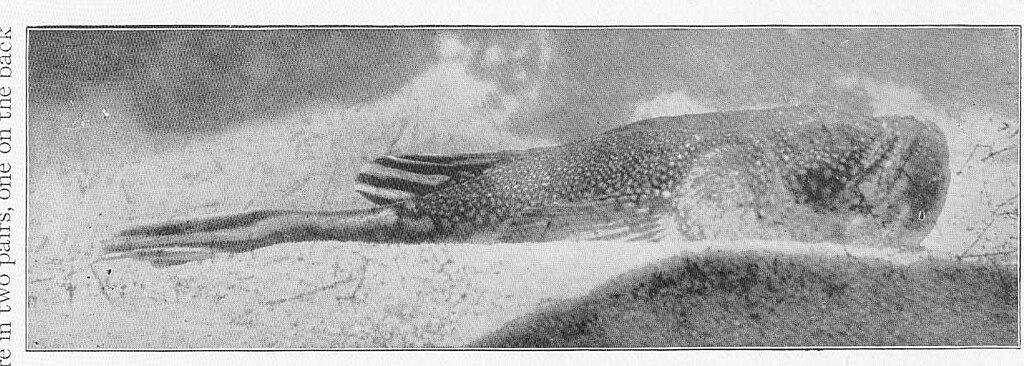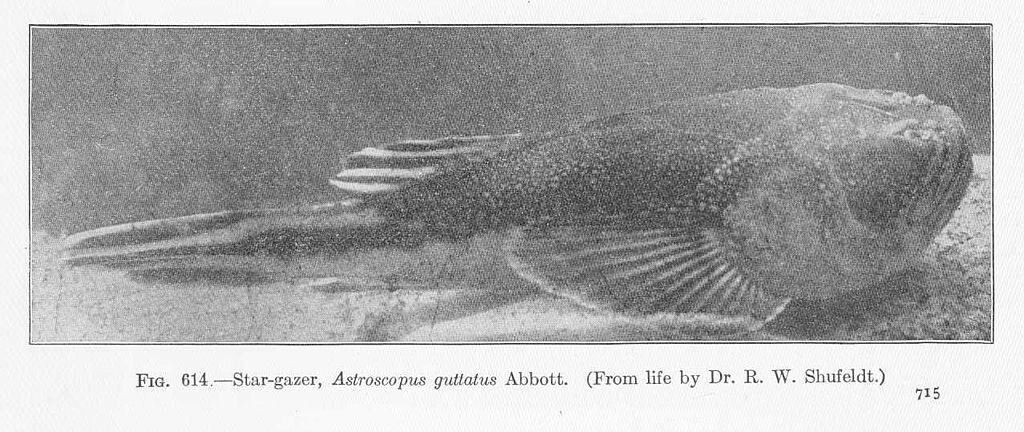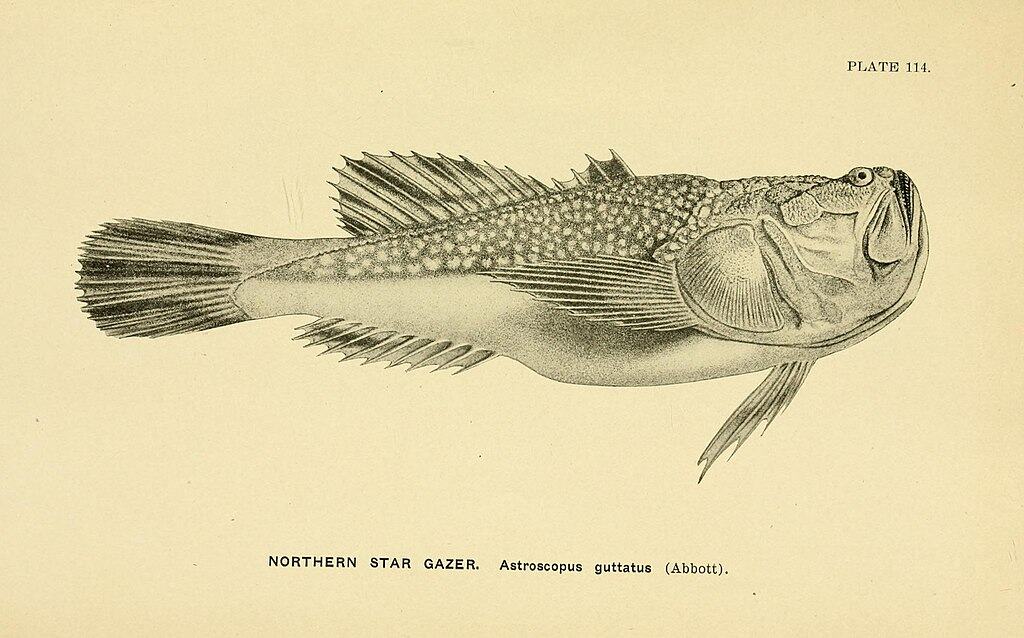In the natural world, patience isn’t just a virtue—it’s a survival strategy. While many predators rely on speed and strength, some have evolved extraordinary patience, turning stillness into a deadly weapon. Among these masters of the wait, one stands out as perhaps the most patient hunter on Earth. The northern stargazer fish (Astroscopus guttatus) can remain motionless for days on end, buried in sand with only its eyes and mouth visible, waiting for the perfect moment to strike. This remarkable predator challenges our understanding of hunting strategies and demonstrates that in nature, sometimes the most effective approach is simply to wait. Let’s explore the fascinating world of this extraordinary ambush predator and discover how patience has become its most lethal weapon.
The Ultimate Ambush Predator: Meet the Northern Stargazer

The northern stargazer (Astroscopus guttatus) is a fascinating marine fish native to the western Atlantic Ocean, found primarily along the eastern coastline of the United States from New York to North Carolina. This unusual-looking predator gets its name from its upward-facing eyes that appear to be gazing at the stars. Growing to about 22 inches (56 cm) in length, the stargazer possesses a flat, robust body covered in dark brown or black coloration with irregular white spots that provide excellent camouflage against the sandy ocean floor.
What makes the stargazer truly remarkable is its specialized anatomy designed specifically for ambush hunting. Its mouth is positioned on the top of its head alongside its eyes, creating a perfect trap for unsuspecting prey swimming overhead. This unique configuration allows the stargazer to remain almost completely buried in the substrate while maintaining clear visual contact with potential meals. Combined with its exceptional patience, this anatomical design makes the northern stargazer one of nature’s most effective ambush predators.
The Art of Disappearing: How Stargazers Conceal Themselves

The northern stargazer’s hunting strategy begins with near-perfect concealment. Using powerful pectoral and tail fins, the fish vigorously buries itself in the sandy ocean bottom, leaving only its eyes and mouth exposed. The process is remarkably fast and efficient, typically taking less than 30 seconds. Once buried, fine sand particles settle over the fish’s exposed parts, further enhancing its camouflage. The stargazer’s rough, mottled skin texture breaks up its outline, making it virtually indistinguishable from the surrounding seafloor.
What’s particularly impressive is how the stargazer maintains its position once buried. Specialized gill structures allow it to breathe while remaining stationary, drawing water through small openings and expelling it through hidden gill slits. This adaptation enables the fish to remain completely motionless for extended periods without compromising its respiratory needs. The stargazer can also adjust its depth in the sand with subtle movements, ensuring optimal positioning while remaining concealed. This masterful disappearing act forms the foundation of the fish’s extraordinarily patient hunting strategy.
The Record-Breaking Wait: Days of Perfect Stillness

The northern stargazer’s patience defies conventional understanding of predatory behavior. Marine biologists have documented these remarkable fish remaining in the same buried position for up to 72 hours—three full days—without moving more than a few millimeters. This extreme stillness isn’t merely impressive; it’s a critical survival adaptation. The slightest unnecessary movement could alert potential prey or expose the stargazer to its own predators. Studies conducted at marine research facilities have confirmed this exceptional patience, with monitored specimens maintaining their ambush positions through multiple day-night cycles.
What makes this extended waiting period even more remarkable is that the stargazer accomplishes it without entering any form of torpor or reduced metabolic state. Unlike some snakes or other predators that enter low-energy states between meals, the stargazer remains fully alert and responsive throughout its waiting period, continuously processing visual information and ready to strike at a moment’s notice. This combination of extreme patience and constant readiness represents one of the most specialized hunting strategies in the animal kingdom.
The Lightning Strike: When Patience Transforms Into Action

When the northern stargazer finally does move, the transition from absolute stillness to explosive action happens in less than 60 milliseconds—faster than a human eye can track. Using powerful muscles that have remained tensed and ready throughout its long wait, the stargazer creates a vacuum by rapidly opening its large, upward-facing mouth. This sudden suction force, combined with a quick upward lunge, pulls unsuspecting prey into its jaws before they can react. High-speed camera footage has revealed that the stargazer’s strike is among the fastest feeding movements of any marine predator, reaching acceleration rates that momentarily subject the fish to forces several times that of gravity.
The effectiveness of this attack is staggering, with studies showing success rates exceeding 80% when prey passes within the stargazer’s strike range. The extreme contrast between days of perfect stillness and milliseconds of explosive movement represents a hunting strategy refined to perfection through millions of years of evolution. For the stargazer, patience isn’t merely a virtue—it’s the setup for one of nature’s most efficient predatory mechanisms, proving that sometimes the deadliest hunter isn’t the fastest or strongest, but the one willing to wait the longest.
Electrical Surprises: The Stargazer’s Shocking Secret

Adding to its arsenal of specialized hunting adaptations, the northern stargazer is one of the few fish species capable of generating electrical charges. Behind its eyes, the stargazer possesses specialized electrical organs derived from modified eye muscles. These organs can produce discharges of approximately 50 volts—not enough to seriously harm humans but sufficient to stun small prey fish that escape its initial suction attack. This electrical capability serves as a secondary capture mechanism, ensuring that even prey that initially evades the stargazer’s powerful vacuum-like strike doesn’t escape.
The electrical organs also serve another fascinating purpose in the stargazer’s patient hunting strategy. Research suggests that the fish can emit low-level electrical pulses while waiting in ambush, which may attract certain prey species that are sensitive to electrical fields. This adaptation effectively transforms the stargazer from a passive ambush predator to one that actively lures prey while maintaining its motionless position. The combination of extreme patience, lightning-fast strikes, and electrical capabilities makes the northern stargazer one of the most uniquely specialized predators in marine ecosystems.
The Metabolic Mystery: How Stargazers Sustain Long Waits

One of the most intriguing aspects of the northern stargazer’s patient hunting strategy is how it manages its energy requirements during extended waiting periods. Research into the fish’s physiology has revealed several adaptations that enable its remarkable endurance. The stargazer possesses an unusually efficient slow-twitch muscle fiber composition that minimizes energy expenditure while maintaining the necessary tension for its ambush position. Additionally, its liver stores large reserves of lipids that can be slowly metabolized during waiting periods, providing a steady energy supply without requiring frequent feeding.
The stargazer’s circulatory system also shows specialized adaptations for its patient hunting style. Blood flow is precisely regulated to prioritize vital organs and the sensory systems needed for detecting prey, while circulation to less essential body regions is reduced during waiting periods. Studies examining the fish’s metabolic rate have found that actively hunting stargazers can reduce their oxygen consumption by up to 60% when in ambush mode. These physiological adaptations allow the stargazer to maintain its vigilant waiting game for days at a time without compromising its ability to launch a successful high-energy attack when opportunity finally presents itself.
Comparing Patience: How Stargazers Outclass Other Patient Predators

While many predators employ ambush tactics, few can match the northern stargazer’s extreme patience. The crocodile, often considered the epitome of patient hunting, typically waits for hours rather than days before repositioning. The praying mantis, another renowned ambush predator, rarely maintains a single hunting position for more than several hours. Even specialized ambush fish like the stonefish or anglerfish typically reposition after 8-12 hours if unsuccessful. The stargazer’s ability to maintain a single ambush position for up to 72 hours places it in a category of patience that few other predators can approach.
What further distinguishes the stargazer’s patience is that it remains in a state of constant readiness throughout its wait. Unlike some predators that enter low-energy states between active hunting periods, the stargazer maintains the muscular tension and sensory alertness necessary for an instantaneous response. This combination of extreme waiting duration and constant readiness represents one of the most specialized hunting strategies in the animal kingdom. The evolutionary advantage this provides is clear: by outlasting the patience of both prey and competing predators, the stargazer creates hunting opportunities that would otherwise be unavailable.
Evolutionary Development: The Path to Perfect Patience

The northern stargazer’s extraordinary patience didn’t develop overnight but is the result of millions of years of evolutionary refinement. Fossil records indicate that stargazers have existed for at least 50 million years, with gradual anatomical changes pointing toward increasing specialization for ambush hunting. Early ancestors likely possessed the upward-facing eyes but lacked the highly specialized mouth structure and electrical organs of modern stargazers. Over time, natural selection favored individuals with greater ambush capabilities, including those that could remain motionless for longer periods.
The evolutionary pressure driving this specialization was likely intense competition in shallow marine environments. In these habitats, prey fish developed increasingly sophisticated predator detection mechanisms, forcing predators to either become faster or better at concealment. The stargazer took the concealment route to the extreme, developing not just excellent camouflage but the physiological capacity for extended motionlessness. This evolutionary path represents a fascinating example of specialization, where a predator sacrifices versatility for extraordinary proficiency in a single hunting strategy. The result is a creature perfectly adapted to its ecological niche, capable of patience beyond what seems biologically reasonable.
Patience in Parenthood: Stargazer Reproduction and Offspring Care

The northern stargazer’s patience extends beyond hunting to its reproductive behavior. During breeding season, which typically occurs in late spring to early summer, male stargazers create elaborate nests by clearing depressions in the sandy bottom. After attracting a female through electrical signals and displays, the female deposits thousands of eggs in the nest. What follows demonstrates another aspect of the stargazer’s remarkable patience: male stargazers guard these nests vigilantly for up to three weeks without leaving to feed, maintaining a protective watch over the developing eggs.
During this guarding period, the male actively aerates the eggs by fanning them with his pectoral fins and removes any debris that might compromise egg development. This extended parental care is unusual among marine fish and represents a significant energy investment. Research indicates that male stargazers may lose up to 15% of their body weight during this guarding period. The evolutionary advantage is clear: by patiently protecting their offspring during their most vulnerable stage, stargazers significantly increase juvenile survival rates. This reproductive patience complements their hunting patience, suggesting that the capacity for extended, focused attention is deeply integrated into multiple aspects of stargazer biology.
Scientific Studies: Documenting Nature’s Most Patient Predator

The northern stargazer’s exceptional patience has made it a subject of significant scientific interest. In a landmark 2008 study published in the Journal of Experimental Marine Biology and Ecology, researchers used time-lapse photography to document stargazers maintaining the same ambush position for periods exceeding 60 hours. More recent research using underwater video arrays has extended this observation to the current record of approximately 72 hours. These studies have been instrumental in confirming the stargazer’s status as potentially the most patient predator on Earth.
Physiological research has provided equally fascinating insights. A 2015 study published in Comparative Biochemistry and Physiology employed respirometry techniques to measure oxygen consumption during extended waiting periods, revealing the remarkable metabolic efficiency that enables the stargazer’s patience. Neurological studies have examined how the stargazer’s brain maintains vigilance during extended waiting periods, identifying specialized neural circuits that prevent habituation to visual stimuli. This growing body of research not only confirms the stargazer’s exceptional patience but is helping scientists understand the physiological and neurological mechanisms that make such extreme waiting behavior possible.
Conservation Status: Protecting the Patient Predator

Despite its remarkable adaptations, the northern stargazer faces increasing environmental challenges. While not currently listed as endangered, coastal development, pollution, and commercial fishing practices have impacted its shallow water habitats along the eastern United States. Bottom trawling, in particular, poses a significant threat as it disrupts the sandy substrate the stargazer depends on for its ambush strategy. Climate change and resulting ocean acidification may also affect the distribution and abundance of the small fish and crustaceans that comprise the stargazer’s diet.
Conservation efforts specifically targeting the northern stargazer remain limited, though the species benefits from broader marine protection initiatives in its range. Marine protected areas along the Atlantic coast provide some sanctuary, while fishing regulations in certain areas limit bottom trawling during stargazer breeding seasons. Increased scientific interest in the species has also raised public awareness about this unusual fish and its extraordinary patience. Conservation biologists emphasize that protecting such specialized predators is essential for maintaining healthy marine ecosystems, as their unique hunting strategies contribute to the ecological balance by targeting prey species that might otherwise escape more conventional predators.
Lessons from Nature’s Master of Patience

The northern stargazer’s extraordinary hunting strategy offers profound insights into the diverse paths evolution can take. In a world that often celebrates speed, strength, and constant activity, the stargazer reminds us of the power of patience and stillness. Its success demonstrates that waiting can be not merely a passive state but an active, sophisticated strategy requiring specialized adaptations and remarkable discipline. This challenges our conventional understanding of predatory behavior and highlights the incredible diversity of solutions that have evolved to solve the universal challenge of securing food.
Beyond biology, the stargazer’s patience offers a compelling metaphor that resonates across disciplines. From military strategy to business and even personal development, there are situations where the capacity to wait for the perfect moment provides a decisive advantage. The stargazer teaches us that patience isn’t merely the absence of action but can be a powerful strategy in itself. As we face a world of increasing pace and constant stimulation, perhaps there’s wisdom to be found in the example of this remarkable fish, which has perfected the art of waiting through millions of years of evolution. The northern stargazer stands as nature’s testament to the power of patience—a master predator that has turned stillness into one of the most effective hunting strategies on Earth.
- Eagles vs. Snakes: Who Would Win? - August 9, 2025
- Why Pandas Were Once Nearly Extinct—and How China Saved Them - August 9, 2025
- This Fish Has the Most Teeth in the Ocean—And Uses Them Well - August 9, 2025

